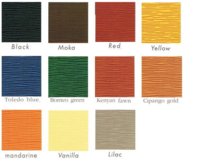I found some good color reference article- about what year was what epi reliesed..
Shame the pics are not working..
Sign In Help
SEARCH
เฮือนข้าเจ้า....สาวสารภี
HomeBlogPhotosVideoMusicCalendarReviewsLinks
phidcha
Picha mon
Personal Message
Report Abuse
View Contacts
Picha Mon
สร้างลิงค์ของโปรไฟล์ในแบบที่เป็นตัวคุณเอง
Louis vuitton Epi Guide May 6, '09 2:45 PM
for everyone
Why do we so love Louis Vuitton epi leather? Why do we look forward with anticipation and speculation to new color introductions? Why do we collect discontinued colors and styles with almost evangelical enthusiasm? Some of those answers can be found just browsing through its history and the colors themselves.
Louis Vuitton has been using natural cowhide to enhance and strengthen it's travel bags since it's earliest days in Paris in the mid 1800's. In 1985, when Louis Vuitton introduced the Epi Leather line, they recognized the deep relationship they've had between leather and color. In fact, from the luxurious Edwardian era of "La Belle Epoque" to the whimsy of the carefree Roaring 20's, Louis Vuitton had used a variety of colorful leathers in it's custom creations... from brown alligator and purple seal skin to green reptile and red morocco.
Louis Vuitton's Epi line was created in response to the need to have a good, durable leather for use in modern travel conditions. Epi leather is dyed all the way through and has a grained texture. It is made to pass the test of time. While vachetta trimmed bags need special treatment in inclemant weather or heavy humidity, epi is weather resistant.
1985: Kouril Black Epi, Kenyan Fawn, Borneo Green, Toledo Blue, Winnepeg Sable.
Black Epi
Kenyan Fawn Epi
Borneo Green Epi
Toledo Blue Epi
Winnepeg Sable Epi
Black Epi: Still around and hasn't changed much since it's introduction.
Kenyan Fawn: Discontinued. A nice, warm brown color with a touch of cinnamon. These brownish colors all get kind of confusing, so I hope to help here. This color is not as brown as Moka. A bit more, like I said above, cinnamon.
Borneo Green: Discontinued. A cross between grass and forest green.
Toledo Blue: Discontinued. A fairly bright, deep blue.
Winnepeg Sable: Discontinued. Introduced as a slightly more sober and conservative option. This is a tan color. It photographs slightly yellow, but it's pretty tan "in real life". Again, in comparison to other colors- this is much more of a flat, sandy color than Cipango Gold.
1987: Castillian Red Epi
Castillian Red Epi
Castillian Red: Discontinued. A bright red, with more orange undertones than the red around today.
Some of these early blue, green and red epi bags were done in a really striking black contrast stitching that you do not see today.
1990: Cipango Gold Epi
Cipango Gold Epi
Cipango Gold: Discontinued. A warm, gold- almost caramel color. Not as brown as Kenyan Fawn, more caramel than Winnepeg Sable.
1993: Tassil Yellow Epi
Tassil Yellow Epi
Tassil Yellow: Discontinued. A bright, sun yellow. It has a really incredible purple contrast lining.
2000: Vanilla Epi, Lilac, Pepper and Moka
Vanilla Epi
Lilac Epi
Pepper Epi
Moka Epi
Vanilla: Discontinued. A light, creamy color a tint of yellow- like a light buttermilk perhaps, but not bright like Tassil at all!
Lilac: Discontinued. This is a really pretty, dusty lilac color. It photographs a lot like Pepper Grey epi, but in real life it's easy to see the pretty, almost lavendar color.
Pepper: Pepper: Discontinued. A fairly light, smokey grey color. Often confused with lilac, but really looks nothing like it.
Moka: Discontinued. A good, milk chocolate brown. Missing the red that makes Kenyan Fawn unique. Darker than Cannelle.
Spring 2001: Epi Plage- Grenadine Red, Coconut, Orange
Louis Vuitton introduced a fun, vinyl, transparent epi beach line that it called Epi Plage. There were three fun, bright colors, each with a golden tint.
Grenadine Red Epi Plage
Coconut White Epi Plage
Orange Epi Plage
2003: Mandarin Epi and Myrtille.
Mandarin Epi Myrtille Blue Epi
Mandarin: Discontinued. Mandarin is an orange, with yellow undertones. It's much more orange than Tassil and varies from Cipango Gold in that it has no tan, brown tones at all. It's true orange- like the fruit!
Myrtille Blue: A deeper blue than Toledo. It has a more cloudy, twilight look.
2006: Cannelle Epi and New Red
Cannelle Epi New Red Epi
Cannelle: Italian for cinnamon, is REALLY a light milk chocolate color. Coffee with cream? Darkk Tan. Lighter than Moka, but same color family.
New Red: New red is a more winter red than Castillian. It has blu-ish undertones, more blood than the orange in the older red.
2007: White Epi
White Epi
White: This really is a good white color. It has some variations, due to the striations of the epi texture, but it's pretty much true white.
Credit
www.fashionphile.com
Prev: How to spot fake Louis vuitton #Multicolor Guide#1
Next: Mitt barn!!!!
reply
0 CommentsChronological Reverse Threaded
Add a Comment
Shop Online in the Marketplace · Philippines Marketplace · Indonesia Marketplace
© 2012 Multiply · English · About · Blog · Terms · Privacy · Corporate · Advertise · API · Help · Sitemap

 . Here is the compiled EPI Charts...I have added a little more dates that I am aware of... If anyone has others please chime in
. Here is the compiled EPI Charts...I have added a little more dates that I am aware of... If anyone has others please chime in



